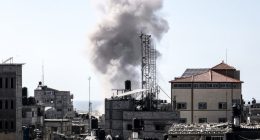Born just before the steam engine was invented, Turner gloried in the smog and grime of the industrial revolution – but today’s artists reveal the damage emissions cause
On 10 April 1815, the Tambora volcano in Indonesia erupted with colossal force. The largest volcanic eruption of the last 10,000 years sent, more than 36 cubic miles worth of shattered rock into the atmosphere. Average temperatures dropped worldwide, turning 1816 into the “year without a summer”.
Because polluted air scatters sunlight and makes it appear redder, the levels of ash and gas in the atmosphere also resulted in some spectacular sunsets – a phenomenon captured in paintings by JMW Turner. The effect was so significant that scientific researchers have been able to correlate the red-to-green pigment ratios in Turner’s paintings to data about the levels of volcanic matter in the air – and conversely to develop a methodology for using historic visual art to identify levels of pollution for places and times about which there is little data.




